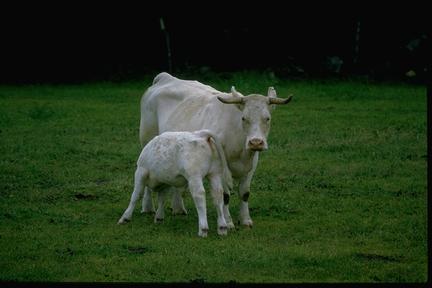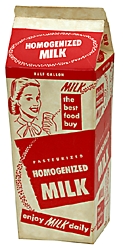Dairy farms

The Cows
Digestion
Cows can weigh between 850 and 1,000 pounds. Cows eat mainly grains and grasses, although they will also eat fresh apples and other foods when given a chance. Although hay and most of the foods the cow eats are tough and difficult to digest, a cow has four stomachs for digestion.
The first two parts of the stomach are called the rumen and the reticulum. The rumen is a large pouch the food passes into when the cow swallows. After a cow has eaten its fill some of the food moves to the reticulum where it is rolled into balls which the cow coughs up.
The cow then chews this food a second time. The second chewing is referred to as the cow "chewing its cud". The cud is then swallowed and returns to the rumen. From time to time food moves from the rumen to the third part of the stomach, the omasum. This third stomach digests the food further. Finally, the food passes to the fourth stomach part, or abomasum, where the cow finishes digesting it.
Production

A cow produces approximately 1000 gallons, 4,000 liters, of milk each year. A cow only produces milk when she has given birth to a calf. One calf drinks about 2.5 to 3 gallons of milk a day. Dairy farmers separate a calf from its mother after only one or two days. Then they are fed milk from a bottle for two or three months. The farmer begins to introduce hay and grain about one week later.
By separating the calf from the cow and feeding the cow plenty of food the farmer is able to produce more milk than the calf requires. A well fed dairy cow, which is milked twice a day, can produce up to 6 gallons of milk per day.
There are several different types of dairy cows. Different types of cows produce different types of milk. Some produce large quantities while others produce a richer, creamier type of milk. Cows even produce different colors of milk.
Types of Cows
Dairy cows include Holsteins, Guernseys, Ayrshire, Brown Swiss, and Jerseys. Although the Holsteins tend to be the most popular type of cow because they produce a large quantity of milk, one dairy farm may raise several different kinds of cows to balance the amount of cream they yield.
The Farms
At one time family run dairy farms were all across the United States. Today many of these family farms have changed into larger and ever expanding agribusiness. Milking machines have made it easier for less people to tend to and milk a larger number of cows. Rather than solely grazing the land the cows are fed prepared food mixed with a variety of nutrients, antibiotics, and other ingredients which help the cows to produce more milk.
These types of farms are able to produce larger quantities of milk with less labor, driving the cost of milk purchased in a store down. Generally these farms take up less land per cow and there is little or no damage from overgrazing. However, these types of farms also have disadvantages. There have been complaints about the types of additives mixed into the cows’ feed as well as complaints about the treatment of the dairy animals.
As a result of such complaints small family dairies attempt to stay in business and organic dairies have begun to spring up across the country.
Dairy Activities
Collections
Some people enjoy collecting and trading milk paraphernalia. These items include glass milk bottles, milk bottle caps, and the first waxed paper milk containers. Once it was common for milk to be delivered from house to house. At this time milk was packaged in glass bottles each with its own separate cap. Later waxed paper containers were sometimes used to package milk.
Now milk is available in waxed milk cartons or plastic jugs. Small individual servings of milk are also available. Glass bottles are rarely used today, so the old bottles and their caps have become collectors items.
Try collecting some of these older dairy items. Add to the collection a variety of newer containers in different sizes, including those that contain dry milks. Small children usually enjoy collecting plastic milk jug caps. They can use the caps for counting, sorting, building, or gluing activities. Just remember to recycle the plastic milk jugs.
Make A City

You will need:
- clean, dry milk cartons of various sizes
- glue or tape
- construction paper
- scissors
- markers, crayons, or paints
- other small craft items such as cotton balls, sequins, or material scraps
The shape of most milk cartons is similar to the shape of a house with a peaked roof. Cover the sides of a milk carton with construction paper cut to fit the carton. Glue or tape the paper in place. Use a different color paper to cover the peaked top. Glue or tape this paper in place.
Use the markers, crayons, or paints to add details to the house. Draw doors and windows on the carton sides. Last use the other craft materials to make each house unique. Sequins might make nice door knobs and cotton balls could become bushes.
Decorate each milk carton differently and arrange them to create a small town or large city. Can you add a balcony or chimney to a house? What other interesting features could you add? Are you able to make houses with doors that move?
Books for Children
- See How They Grow Calf by Gordon Clayton - An informative book with nice photographs explaining how a calf grows and changes from birth to cow. Appropriate for children ages 2-7. (amazon.com has it)
- A Picture Book of Cows by Dorothy Hinshaw Patent - This describes the way cattle are raised on a ranch both for milking and for meat. Black and white photographs are used on each page. Appropriate for children 9 and older. This book is currently out of print so check your local library for a copy.
- The Milkman's Boy by Donald Hall - An interesting story of the life of a dairy farm family at the time when pasteurization was first being introduced. For children ages 4-8. (amazon.com has it)
- Portrait of a Farm Family by Raymond Bial - A fairly in-depth look at life on a dairy farm as it competes to make a profit. Appropriate for children 9 and older. (amazon.com has it)
- Down Buttermilk Lane by Barbara Mitchell - This book is a story about a day in the life of an Amish family. References to the milking of cows is brief, but it gives children an introduction to a different culture reminiscent of the past. A nice book for children ages 4-8. (amazon.com has it)
Links
- Penn State Dairy Cattle Nutrition Home discusses everything a person might want to know about dairy cattle, including the internal digestive tract, to droughts, and silage usage.
- The Story of Milk tells about milk starting with information about dairy cows at Moo Milk.
- Horizon Organic Dairy has information about their products as well as an education section..
- The National Association of Milk Bottle Collectors, Inc. Lots of links to milk bottle and milk bottle cap collectors' pages, plus a few historical photographs.
Related Subjects
Find out what happens after a cow has been milked on our Dairy Foods page.

